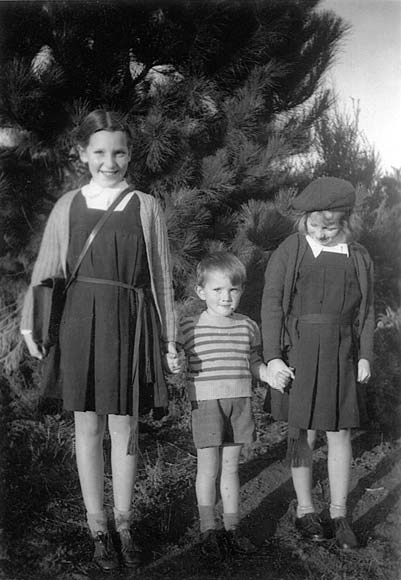
Jocelyn Buckett (later Keith), her brother Rob and sister Lindy pose for the camera at Pinedale in April 1948. Pinedale, situated east of Putaruru, was a thriving timber town in the 1940s.
What\'s you story?
Contributed by Jocelyn Keith
Pinedale no longer exists. All the houses made of untreated pine have literally, as my father used to say, grown into the ground. So the village where I lived from 1940 to 1948 no longer exists. The timber mill that was the heart of the village was in the hollow between two hills. My father was the mill manager, so we lived on one hill and everyone else lived in the village on the other hill. The mill office was on the left side across from the mill, and the railway line ran from Rotorua to Putaruru on the far side of the mill, past the smouldering sawdust heap and the skids.
When I began school in 1943 there was a debate in the family about whether I was going to Putaruru School or doing correspondence lessons at home with my mother and sister. The stumbling block was transport – the train or the bus. The train was close by, the bus at the far end of the village. Schoolchildren travelled in the guards’ van. The previous stop was at the pā so the guards’ van was full of Māori children. Māori was the language of the guards’ van, but was forbidden at school. For a nervous little five-year-old Pākehā child, without word of te reo, it was a bewildering experience, but the alternative was correspondence lessons and I was determined to go to real school. By the time my sister came with me a couple of years later we were deemed old enough to walk down our hill, past the office and up the winding path to the village to catch the school bus with all the other children. ‘Maori Battalion’ was the favourite song of the bus.
Pinedale was a thriving community with lots of children and lots of social events. The village hall was the venue for dances and for Sunday school, which my sister and I attended every Sunday, oblivious of the arrangement that the various religions alternated, treasuring the decorated certificates for good attendance etc.
The movies were in Putaruru, so as far as we were concerned they might have been a million miles away. My mother did not drive, so groceries, meat and vegetables were ordered by telephone from Barr Browns, and we optimistically added ‘skipping rope’ to the end of the list each time but somehow it never arrived. Milk was dippered out into billies at the gate. Shoes etc. meant a trip to Rotorua – an annual event.
Special memories include the time we saw the aurora australis dancing across the night sky. Our father thought it was a bush fire and we drove home at breakneck speed. And then there were the real bush fires, when the men came in black and exhausted. We had had classes in a church hall for a year after the fire at Putaruru School in 1945. I remember the man who painted our house and who never left the property for the entire time (it turned out that he was a prison escapee on the run).
Another memory is racing into the new school for five minutes to say goodbye to my class in October 1948 when we left for Auckland. It was before the days of social promotion so some of my classmates were large boys of 13 or 14.
I never went back – it was on to Howick District High School and from there to St Cuthbert’s College for young ladies! And now Pinedale as it was is no more.
Te whakamahi i tēnei tūemi
Private collection
This item has been provided for private study purposes (such as school projects, family and local history research) and any published reproduction (print or electronic) may infringe copyright law. It is the responsibility of the user of any material to obtain clearance from the copyright holder.













Tukunga
Great memories of Pinedale
Harko Brown (not verified)
15 o Hepetema 2020
Hi I lived in pinedale from
Shannon James (not verified)
21 o Hune 2015
I also keep in touch with
Jean Way(Eastwood) (not verified)
13 o Oketopa 2014
The people who were in the
jean (not verified)
18 o Hune 2013
Hi I also lived at Pinedale
Lorene Clotworthy (not verified)
18 o Mei 2012
Moved to Pinedale from
Jean Way( Eastwood) (not verified)
11 o Hūrae 2011
I also lived in Pinedale
Gerry Mullane (not verified)
11 o Oketopa 2010
Tāpiritia te tākupu hou